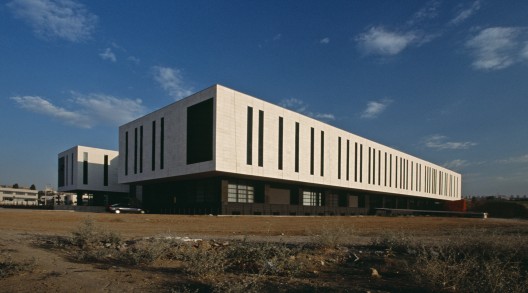 |
| Source: SoHo Architektur archdaily.com |
Haus BRU 1.25, Heimertingen, Bavaria, Germany, 2008 designed by / SoHo Architektur
Decisions on construction method, materiality and quality were primarily based on building costs. Fair faced interior walls, screed as finished flooring, visible insulation strips between floor and walls, and the use of corrugated cement fibre panels for facade cladding and roofing – no need for rainpipes and gutters – help to reduce the costs. The timber building enables a strong connection between interior and exterior through the accurately positioned openings on ground level. -- ArchDaily
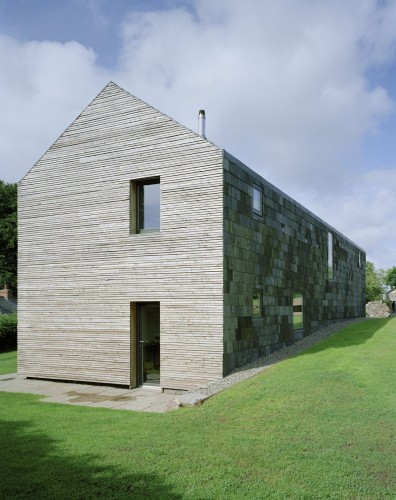 |
| Source: David Grandorge archdaily.com |
Ty Pren, Brecon Beacons National Park, King’s Rd, Llandovery, Dyfed SA20 0AW, UK, 2009 designed by Feilden Fowles
The rich local vernacular inspired the concept of a modern ‘long house’, following the contours of the land, embedding itself in the slope of the hill and responding to the prevailing conditions. The design evolved into a crisp extrusion using skilled craftsmen to deliver a high-tech building. The typology of the long house leant itself to a passive solar plan, enhanced by the topography and aspect of the site. Contemporary construction techniques have delivered a thoroughly modern and high performance building, which responds to the landscape. The design was environmentally driven throughout. The passive solar design strategy uses every natural energy source available, and is supplemented with active features such as the log boiler. -- ArchDaily
 |
| Source: openbuildings.com |
Sliding House, Suffolk, UK, 2009 designed by dRMM de Rijke Marsh Morgan Architects
The brief was a self-build house to retire to in order to grow food, entertain and enjoy the landscape. The site offered a combination of rolling England and agricultural Holland, restrained by stringent local Planning parameters for rural development. A genuine appreciation of vernacular farm buildings shared by architect and client/builder led to a manipulation of the local timber framed and clad 'shed' idiom. -- Open Buildings
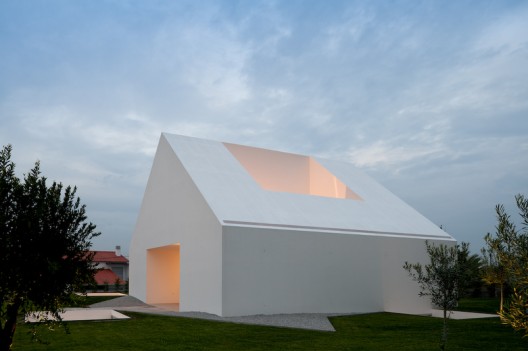 |
| Source: FG+SG – Fernando Guerra, Sergio Guerra archdaily.com |
House In Leiria, Leiria, Portugal, 2010 designed by Aires Mateus
The house is a recognizable archetype emptied of its centre by the light designed by a three heighted courtyard that opens horizontally at the garden level. The bedroom courtyards, revealed in the garden, relate with this archetypal object providing different readings on its scale. Scale and volume are controlled in a chaotic context, with a clear identity that from its core relates with the historical legacy far away: the Leiria Castle. -- ArchDaily
 |
| Source: Nelson Garrido archdaily.com |
Casa na Areia, Comporta, Grândola, Portugal, 2010 designed by Aires Mateus
This project is a response to very specific conditions. Its basis is the recovery of existing wood-masonry buildings, providing the complex with a homogeneous unity under a sloping roof. The design begins with the existing material conditions, depending on their inhabitation potential. -- ArchDaily
 |
| Source: Roberto de Leon archdaily.com |
Yew Dell Gardens Visitor Center, Crestwood, Kentucky, USA, 2010 designed by De Leon & Primmer Architecture Workshop
The Yew Dell Gardens Visitor Center is situated within the historic property of the Garden Conservancy. The project required the rehabilitation of an existing tobacco barn with a program including a reception area, information and tickets sales, gift shop, plant sale area, group tour meeting zone, internet sales office, and storage. Preserving the exterior iconic image of the tobacco barn structure, the new facility is designed as a ‘building-within-a-building’. -- ArchDaily
 |
| Source: Satoshi Shigeta archdaily.com |
House in hieidaira, Shiga Prefecture, Japan, 2010 designed by Tato Architects
The houses in the nearby existing residential area are gable-roofed keeping to the regulation that demands slanted roof, which appeared to be providing a sense of serenity along the street.
The floor space of upstairs was not required to be so large but was required to be independent to some extent. As ordinarily upright walls would make the space of upstairs cramped and the ceiling of downstairs too high, the partition walls were leaned to have the solid space divided diagonally, and thereby a ”hill-like-floor” and a ”roof-like-ceiling” emerged. Here appeared such a new model as assembling a small cottage type into a large cottage type. A cottage type is assertive enough to make people imagine the interior to be consistent to the exterior, and vice versa. Above a ceiling suggesting a cottage style roof another ceiling suggesting another cottage style roof is provided, and thereby we think we have created a solid space as if it is ever extending up. -- ArchDaily
 |
| Source: Gustav Willeit archdaily.com |
Casa Prè de Sura, San Martino in Badia, Italy, 2010 designed by Casati
This gabled house in Italy by Austrian architects Casati has stripy wooden walls on the outside and bumpy limestone walls on the inside. Boxy windows project from the facade and frame views towards the castello di San Martino; a small castle on a nearby hillside. A window in the master bedroom wraps over onto the roof, while others meet the floor so that small children can see out. -- ArchDaily
 |
| Source: Sean Breithaupt + Yvette Monohan archdaily.com |
Connemara, Connemara National Park, Ireland, 2010 designed by Peter Legge Associates
The two cottages though close (a mere three metres apart) were not directly in line nor at the same level but were parallel. A basic decision in the redevelopment process was that they should continue to read as separate elements in the landscape. To allow the cottages read as two separate buildings, a transparent link was required, one totally glazed. This link would become the entry and circulation hub for the house connecting the cottages at both levels. -- ArchDaily
 |
| Source: Filip Dujardin archdaily.com |
Habitation TSL, Brussels, Belgium, 2011 designed by adn Architectures
Our first response to a specific domain of work is to propose an
alternative design of interior spaces in a limited volume and restricted
by planning regulations that defy logic. The work is a reflection of the cavity determine by significant mass
elements of the facades, with the input system, solar gain from the
south views where landscape is framed. --
ArchDaily
 |
| Source: Rene de Wit archdaily.com |
Dentist with a View, Best, The Netherlands, 2011 designed by Shift architecture urbanism
The four new treatment rooms are situated in a new volume that at the same time mimics and contrasts the existing house. Its archetypical volume is derived from the existing house – it takes over the exact same inclination of the pitched roof – while it is being materialized in a very different material. Both the roof and the facades of the extension are clad with zinc. This strengthens the iconic quality of the archetype and renders the new extension into a “contextual alien” that blends into the rural surroundings and at the same time creates a clear new landmark that expresses its new function. -- ArchDaily
 |
| Source: archrecord.construction.com |
House in Komazawa, Setagaya-ku, Tokyo, Japan, 2011 designed by Go Hasegawa & Associates
....a gabled roof typical of the neighborhood. On the first floor, large
windows incised in the wood-clad walls offer generous views of nearby
trees. Plywood sheaths the interior walls and gives the open-plan space
a sense of intimacy.
One half of the second floor contains two bedrooms, a bath,
and a narrow, south-facing outdoor terrace. The other half, devoted to a
study,
has a slatted floor of two-by-threes with 1.18-inch gaps. The open
slots allow residents to catch glimpses of activity below and make it
possible for daylight to permeate the two floors. -- Architectural Record
 |
| Source: Brando Posocco archdaily.com |
Villa Jian, Yantai, Shandong, China, 2012 designed by CU Office
The concept of Villa Jian came from the local architecture word called “Jian”. In the local architecture culture, there was one commonly used for building space base unit that is “Jian”, one ”Jian” represented a width of about 3.3 m to3.6 m of spatial scale, this word ”Jian” not only represented a space base unit, but also strongly linked with the local traditional form of construction. -- ArchDaily
 |
| Source: Nobuaki Nakagawa archdaily.com |
ISM House, Chiba, Japan, 2012 designed by I.R.A
The impressive house that has the form of the white arrow was built to the site without an important context. -- ArchDaily
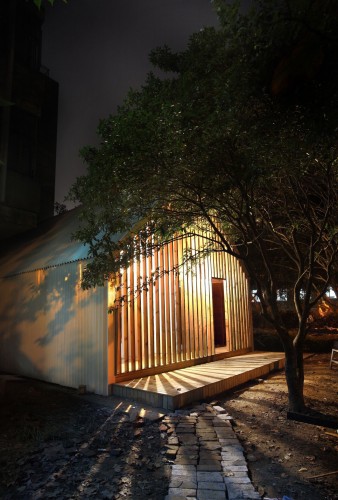 |
| Source: Li Xiao archdaily.com |
N4+ Gluebam House, Wuhan, China, 2012 designed by Advanced Architecture Lab[AaL]
“Glued bamboo prefabricated construction system” ,developed by the
Advanced Architecture Lab(AAL) together with the bamboo institute of the
Chinese Academy of Forestry, is trying to transform the rich bamboo
resource in China into the industrialized building structure material. “N4+”is a housing typology based on gluebam, located in Huazhong
University of Science and Technology, the house is positioned in
proximity with the architectural department. “N4+” house completed in 25
days, is a prototype base on the concept of mass production and
fabrication, delivery to site for fast construction. --
ArchDaily
 |
| Source: Stephane Chalmeau archdaily.com |
Maison 2G, Orsay, France, 2012 designed by Avenier Cornejo Architectes
Flirting with the building regulations of the materials and the context of the landscape led a project of “total look” wood. The volume is simple and one-piece, the wood cladding envelope dramatic. Composed of strips of cedar crate, this one allows omnipresent light, to be so over-input and redirected the angular pants interiors. The volumes are designed and vibrate throughout the day. -- ArchDaily
 |
| Source: Guy Wenborne archdaily.com |
Barn House, Kawelluco, Chile designed by Cazú Zegers G.
A Barn´s wooden skin creates a relation with the surrounding scenery. It does not impose, but incorporates itself, to the traditional type of construction, typical of southern Chile. This Barn house, is a contemporary representation of a traditional barn model. The use of wood covering for walls and roof , creates an interior twice as high festoned with somewhathigh altillo windows and balconies leading to the surrounding landscape. -- ArchDaily
 |
| Source: Jürg Zimmermann archdaily.com |
Gottshalden, Winterthur, Switzerland, 2012 designed by Rossetti + Wyss Architekten
The house in Gottshalden is located on a plateau over the Lake Zurich. It is set in green surroundings with a high quality of life, dominated by agricultural use. The volume exhibits a unified design, with a reduced, sharp-angled timber facade. The building is reduced to an almost graphical figure, with even the minimal distances to the eaves and corners verging on disappearance. -- ArchDaily
 |
| Source: Åke E-son Lindman archdaily.com |
Villa Wallin, Yxlan, Stockholm, Sweden, 2013 designed by Erik Andersson Architects
....the archetypal house. Designed strictly by using the proportional ratio of 1:3, the house measures six meters in depth, eighteen meters in length and six meters in height. The facade windows also follow a clear pattern: they are all square in form and have the same size. -- ArchDaily
 |
| Source: Adolf Bereuter archdaily.com |
Haus am Moor, Vorarlberg, Austria, 2013 designed by Bernardo Bader Architects
Based on the traditional houses of the Bregenz district, the two-storey residence has a simple rectangular plan with a steep gabled profile and a wooden deck driven through its middle. -- ArchDaily
 |
| Source: Maciej Gasienica Giewont archdaily.com |
Public Toilets, Kazimierz Dolny, Poland designed by Piotr Musialowski + Lukasz Przybylowicz
The entire property was surrounded by a fence, inspired by the traditional wooden fences. From the north side, it was transformed into the wooden rail shelter to integrate all elements of the new building. -- ArchDaily
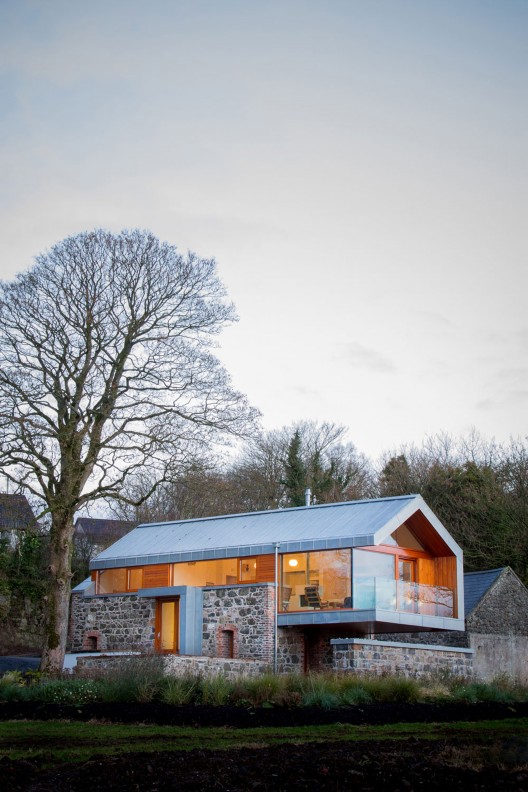 |
| Source: Adam Currie archdaily.com |
Loughloughan Barn, Broughshane, Northern Ireland, UK, 2013 designed by McGarry-Moon Architects
The preservation and consolidation of the stone structure was fundamental in achieving an architecture where the old and new complemented each other. Thus the residence was designed by fusing new technologies with older building techniques whilst incorporating sustainability ideals in order to create a rural architecture for the 21st century, rather than simply remodelling or recreating the methods and manners of the past. -- ArchDaily











































